Innovations in Multifamily Housing
Water-Resistive Barriers (WRBs)
In addition to vapor and air barriers, building codes require water-resistive barriers (WRBs) under all cladding systems to prevent water penetration into building assemblies. WRBs can be as simple as traditional asphalt-impregnated building paper or be as multifaceted as a high-performance, non-woven building wrap made from a synthetic sheeting material. The advantages of a modern synthetic wrap product over building paper include a WRB that is more breathable, more durable, and more easily sealed along the seams to create a continuous barrier over a variety of materials and in different configurations. Further, if the synthetic WRB is breathable and non-perforated, then it can also double as a continuous exterior air barrier, meeting the code requirements for both in a single layer.
When a high-performance building wrap is used as the WRB in a multifamily housing project, it takes advantage of several innovative advances in their development. First, as an engineered product, it creates a weather barrier behind exterior cladding to protect the sheathing and reduce water intrusion into the wall cavities. This is important in all wall systems since all cladding will likely allow some degree of water intrusion at some point. It is also particularly important in rainscreen assemblies where water is expected to enter behind a cladding material and is allowed to drain away. Second, as a vapor permeable or breathable product, WRBs allow water or moisture to escape, thus allowing any damp or wet materials to dry in a relatively short amount of time. During this drying, WRBs maintain their water resistance because they are constructed with pores that are large enough to allow moisture as a vapor to pass through but too small for water as a liquid to pass. Third, as an air barrier, a WRB will be an energy-efficient means to stop air infiltration and exfiltration through walls.
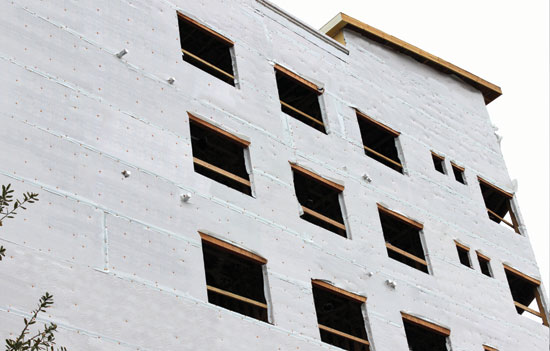
Photo courtesy of Tamlyn
Continuous water-resistive barriers (WRBs) are required by code and provide improved construction performance.
A significant innovation has come about by recognizing that WRBs can be enhanced to very effectively serve as a drainage component that contributes directly to the longevity and sustainability of the rest of the wall. It has been noted that traditional construction techniques such as masonry walls manage water and moisture by using a space or gap between the sheathing layer and the masonry veneer (cladding) to allow any accumulated water to exit through weep holes. Similarly, rainscreen installations use a gap between the cladding and the sheathing to allow water to drain away harmlessly. In any wall construction, failure of water to drain away can damage the cladding, or worse, the rest of the wall assembly. As such, there has been an interest in providing a similar drainage gap between building wraps and cladding.
The conventional means to create a gap in a framed wall system is to use furring channels or strips. This will work, but requires more labor, time, and cost as a result. One innovative alternative that has become recognized as a best practice solution is to use a drainable WRB building wrap that provides its own integrated method of drainage. For example, at least one manufacturer creates this gap by bonding 1.5-mm propylene spacers to a high-performance WRB building wrap. This depth is large enough to provide a true drainage space between the sheathing and cladding material. In essence, it acts as a full rainscreen system in miniature, without the added labor or cost. Further, it will work with all types of cladding systems, particularly those that can be moisture sensitive, such as wood or fiber cement siding.
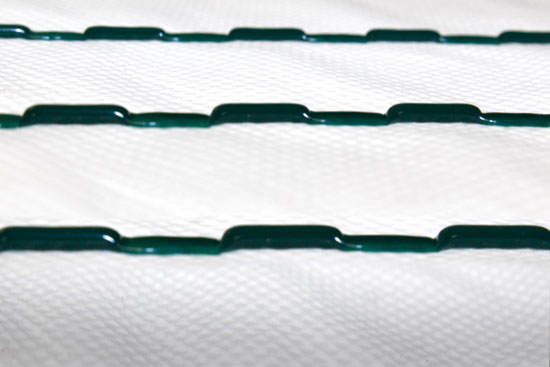
Photos courtesy of Tamlyn
Continuous spacers provide an intended drainage gap on a synthetic, non-woven, breathable WRB.
When specifying WRBs/building wraps for multifamily housing projects, it is important to recognize that there are literally dozens of building wrap products available with wide variations in performance and cost. While most are made from polyethylene or polypropylene plastic, they can also vary in water resistance, drainage efficiency, water vapor transmission or breathability, ability to impede air flow, durability, tear resistance, cold weather flexibility, flammability and smoke developed ratings. Selecting a WRB that excels in all of these areas will assure best results overall. Beyond that, however, it is important that the WRB can be sealed properly and fully along the seams without undue penetrations from staples or nails. Some manufacturers offer full sealing systems that avoid the use of nails and staples and instead use a compatible adhesive, sealant, or tape.
Equally important are the details of how the WRB deals with openings in the wall such as doors and windows. Being able to flash and seal the WRB properly with window and door flashing materials will assure that water draining down the face of a drainable WRB will flow away properly and not behind other building elements into the wall.
Optimizing Performance with Windows
Windows are an integral and important part of any multifamily wall system and as such, they need to address a variety of design criteria. The desire to provide views and natural light needs to be balanced with energy efficiency in the wall system. Energy costs need to be contained by controlling air drafts, solar gain, and heat loss. Occupant comfort needs to be addressed by avoiding air drafts, glare, and overheated spaces. Increasingly, particularly in urban areas, windows play an important role in resisting unwanted noise from outside sources as well. In coastal areas, resistance to the elements and weather including hurricanes becomes a factor. Developers are of course concerned about all of these things since properly addressing them can lead to higher rents in rental properties or purchase prices in condo units. Given all of these various design and user needs, it is not surprising that there are a lot of options and choices in window products being used in multifamily housing that take advantage of the most current technology and product design innovations.
Envelope Analysis
In order to fully account for the impact of windows on building performance, they should be looked at as part of an overall envelope analysis with an emphasis on the contributions offered by glazing types, air sealing, occupant comfort, and improved aesthetics. This is an important step on any project but especially on the renovation of existing buildings, particularly if the building is being converted from some other use (i.e. warehouse, school, etc.) into multifamily housing as has become very popular in many areas. This analysis can be done in-house by architectural firms using available computer modeling software or by working with window manufacturers who have customized software to analyze the options of different window systems in a given building envelope system. Either way, a baseline building can be modeled and the relative changes can be compared by modeling specific window designs, types, and options.
Testing and Standards
Pre-glazed window products are categorized in four standardized classes as identified by the American Architectural Manufacturers Association (AAMA), which is a non-profit trade association of manufacturers and others in the fenestration industry. Using the classifications of R, LC, CW, and AW, windows can be selected that are manufactured and tested to perform under increasing weather and structural demands related in part to the height of a building.
The National Fenestration Rating Council (NFRC) has developed the widely accepted NFRC Rating System to identify the overall energy performance in windows. This uniform rating and certification process quantifies the key elements of fenestration performance starting with the total product thermal transmittance (U-factor) of the window unit not just the U-factor of the glazing. It also identifies the solar heat gain coefficient (SHGC) and visible light transmittance (VT) of a particular window unit so those important factors can be identified. In some cases, they also identify the air leakage (AL) and condensation resistance (CR) of a window product as well. In short, all of these elements can be specified according to the design needs of a multifamily building and verified in the field by the factory-applied NFRC certification label.
NFRC certification is also recognized as the only means for a window unit to qualify for ENERGY STAR certification. The ENERGY STAR label is awarded by the U.S. Environmental Protection Agency to products that achieve superior energy performance compared to baseline minimum requirements. For windows, this means that the U-factor and SHGC values need to meet strict minimum levels under NFRC certification in order to earn the ENERGY STAR label. The levels were first established in 1998 and have been updated several times with the most recent standards effective in January of 2010. Updated performance levels for windows are anticipated to take effect in 2015.
Among the biggest difference between manufactured windows and their performance is the material used for the sash and frames. The common choices for multifamily housing are summarized as follows:
Clad Wood Windows
Wood is one of the best thermal performing materials to use in a window frame system since it provides relatively high thermal resistance and excellent insulating ability. As a result, thermal bridging through the frame is reduced compared to metallic frame materials without thermal breaks. The wood used in the manufacture of window units is selected for strength and a low coefficient of thermal expansion. But perhaps the most dominating advantage of wood is its aesthetic appeal particularly on interiors. Windows made entirely of wood may be preferred in regions where wood construction prevails and exposed wood finish materials are popular. However, this will require ongoing care and maintenance to protect the wood from environmental or insect damage. Hence, wood windows clad on the exterior with a low-maintenance material such as aluminum are more commonly specified, particularly on multifamily projects. This creates a virtually maintenance-free condition on the outside while retaining the appeal of wood on the inside. Clad wood windows are often used where design flexibility is desired, where the warmth of wood will complement other interior woodwork, where low-maintenance exteriors are important, or in older existing buildings that require an authentic look.
Notice
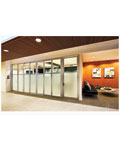
www.spaceplus.com
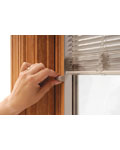
professional.pella.com/windows
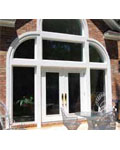
www.simonton.com
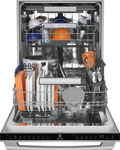
www.electroluxappliances.com
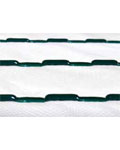
www.tamlynwrap.com









